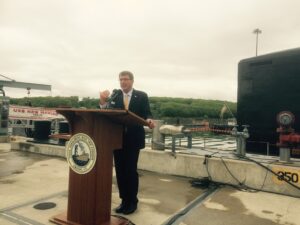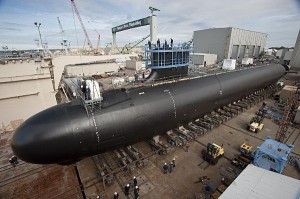Welding Problems Fixed For Virginia Subs; Carter Tours Electric Boat
Posted on

Defense Secretary Ash Carter passes under the tail of the future USS Colorado at Electric Boat’s Groton, Connecticut yard.
UPDATED with Carter statement, Electric Boat clarifications, Hill comment
ELECTRIC BOAT, GROTON, CT: Shipbuilders are fixing the biggest problem on one of the Pentagon’s top priorities, the Navy’s nuclear submarine fleet. As Defense Secretary Ashton Carter toured the Groton shipyard and talked up the importance of submarines, Electric Boat officials told reporters they’re fixing faulty welds in the nuclear-powered propulsion plants of three Virginia-class attack subs. As a result, the long-delayed USS Minnesota will finally leave the shipyard Friday.
“We’ve pretty much identified all of the issues that arose as a result of that vendor,” one Electric Boat official said referring to pipe-maker Nuflo. Other officials were more cautious, since they’re still waiting on the results of some inspections. Electric Boat spokesman Tim Boulay said on the record that: “We are continuing to perform inspections and take appropriate actions to resolve the issues….A great deal of progress has been made.”
Secretary Carter expressed his confidence in the Navy and the shipyards during his visit. “It was a propulsion system weld issue,” the former physicist acknowledged when I asked him at a brief pierside press conference. “The effect of it is, yes, to delay the delivery of one of the new [Virginia-class] boats, and that obviously creates an operational impact that we have to fill and we’re going to fill as we promptly rectify the underlying problem” (i.e. the welds).

Defense Secretary Ash Carter speaks pierside in front of the USS New Mexico at Sub Base New London, Connecticut.
The delay could have been much worse: While Minnesota has been in the shipyard two years, twice the normal maintenance availability after a shakedown cruise, it had been built and delivered 11 months ahead of schedule, canceling out most of the delay.
[UPDATE] Has the welding problem hurt the Virginia program on Capitol Hill? “It’s such a quality program. It really is the acquisition success story of the last 20 years, I think people are reticent to be too critical,” said one Republican Hill staffer. “It’s still — compared to a lot of other Navy programs — a shining success story.” [UPDATE ENDS]
After placing the blame squarely on a subcontractor, the Electric Boat officials told us the question as to who will pay for the problem — the subcontractor, the shipyards, or the government — remains unsettled. The priority, they said, was to get it fixed fast and assign blame later. [UPDATE] All Virginia-class contracts to date explicitly say the government will bear the cost for all damages over $2 million, the Hill staffer said, although there’s a provision in the House draft of the National Defense Authorization Act to change that for future boats. [UPDATE ENDS]
The first sub to display the welding defect, the USS Minnesota, will finally leave the Groton yard this Friday. The welds are also being fixed on the future USS Colorado, in whose shadow Carter spoke today, and on a third sub being built at EB’s partner yard, Newport News Shipbuilding in Virginia.
That’s good news not just for the Virginia — an otherwise exemplary program — but for its 150 percent bigger sibling, the future nuclear missile sub known as the Ohio Replacement Program (ORP). The Ohio Replacement Program “is a huge, centrally important, obviously indispensable part of our national defense because the nuclear deterrent is the bedrock,” Carter told the shipyard workers. “This is one of those issues on which we are completely aligned with the Congress,” Carter added (implicitly contrasting with a host of other issues). “I’m very grateful for that.”
The Pentagon and Congress have invested heavily in the Virginia class, increasing production to two subs a year. (Electric Boat and Newport News divide up different parts of the submarine, but both build the reactor and conduct final assembly, each taking a sub in turn). Attack submarine production is a high priority because aging Reagan-era Los Angeles attack subs are retiring faster than US shipyards can build replacements, just as China and Russia beef up their submarine fleets.
Soon, the much larger Ohio-class ballistic missile submarines (SSBNs) that carry most of the nation’s nuclear deterrent will also grow too old to serve. The first Ohio replacement subamrines don’t have to start patrolling until 2031, but walking backwards from that deadline through all the complex training, testing, and engineering challenges requires delivery to the Navy in 2027, Congressional authorization in 2021, and a massive design effort now.

The Virginia-class attack submarine USS Minnesota under construction in Newport News.
What happens in theVirginia class affects the ORP not just because they’ll be built in the same shipyards by the same people, but because the ORP sub is in many ways a scaled-up version of the Virginia design. While the SSBN is two-and-a-half times the size of the attack sub, its entire nose section and many components will be derived or directly copied from Virginia in order to reduce cost, risk, and time.
That said, both the individual ORP submarine and the shipyards that built it have to be significantly bigger. A Virginia, for example, is built in four huge cylindrical sections, up to 2,000 tons apiece, which EB ships by barge from Newport News or its own Quonset Point, Rhode Island facility for final assembly at Groton. An ORP will consist of six such modules weighing up to 3,000 tons.
“We’ll need a new barge,” said Tom Plante, Electric Boat’s head of strategic planning. They will also need a bigger workforce. It plans to grow from 14,100 employees today to 18,000 at the peak in 2030, with 1,800 hires in this year alone. That’s not counting suppliers and subcontractors, which already total some 3,000 companies — not employees, companies — across the country. And everything in this sprawling enterprise has to work right to avoid any more delays and malfunctions.
Subscribe to our newsletter
Promotions, new products and sales. Directly to your inbox.
